Workshop report by Dr Robin Buning.
More than five years after the workshop Apocalypticism, Millenarianism, and Prophecy: Eschatological Expectations between East-Central and Western Europe, 1560-1670 in January 2009, which was the first event of the Cultures of Knowledge project, Prague was again the scene of a two-day conference on intellectual networks.
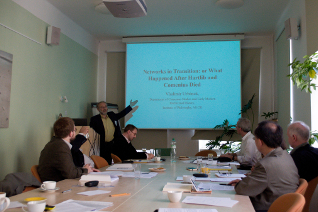
Photo Author: Iva Lelkova
On 18 and 19 September the Institute of Philosophy of the Academy of Sciences of the Czech Republic hosted the workshop ‘The Practise of Scholarly Communication: Correspondence networks between Central and Western Europe, 1550-1700’, organized by Vladimír Urbánek, head of the Department of Comenius Studies and Early Modern Intellectual History, and Iva Lelková, Cultures of Knowledge’s postdoctoral fellow based in the same institute. Scholars from Austria, Bulgaria, the Czech Republic, Germany, Poland and the United Kingdom gathered to present papers and discuss their research. The focus of the workshop was on the comparison of crucial networks, overlaps, intersections and important intermediary persons, issues such as centre and periphery, and individuals. The conference was one of the main outcomes of the Czech Academy-funded project ‘Correspondence Networks Between Central and Western Europe: From Comenius and Kircher to Hartlib and Oldenburg’, which supports cooperation with Cultures of Knowledge and was itself also supported by the project ‘Between Renaissance and Baroque: Philosophy and Knowledge in the Czech Lands within the Wider European Context’ funded by the Czech Grant Agency.
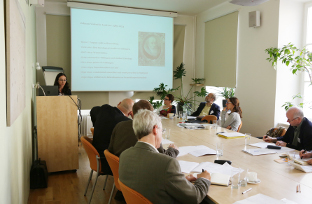
Photo Author: Stanislava Kyselová
After a word of welcome by Ondřej Ševeček, Director of the Institute of Philosophy, Lucie Storchová (Prague) presented the first paper providing an overview of the developments in the methodology of early modern network analysis and the study of scholarly communication, problematizing terms such as ‘network’, ‘circle’ and ‘centre’. The other papers were case studies that interlocked and sometimes even partly overlapped. The result of this was a coherent account of the practises of intellectual exchange in early modern Europe. Paola Molino (Vienna) showed how the network of Hugo Blotius changed throughout his activity as court librarian in Vienna and made a case for this being an early example of an institutional correspondence, since the library, rather than Blotius himself, was at its centre. Stefania Salvadori (Wolfenbüttel) discussed Johann Valentin Andreae’s epistolary contacts with Nuremberg against the background of the Thirty Years’ War and his important contribution to promoting the cultural, theological and artistic exchange between Nuremberg and Wolfenbüttel. On the basis of the recently discovered archive of the Brethren bishop Matouš Konečný, Jiří Just (Prague) discussed the contacts between Matthias Martini, rector of the gymnasium in Bremen, and Brethren bishops about the education of future Brethren churchmen at the gymnasium, and the resulting transfer of theological literature from Bremen to Bohemia and Moravia.
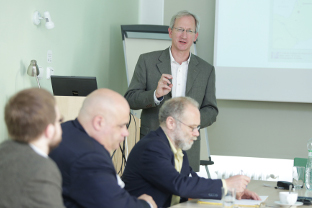
Photo Author: Stanislava Kyselová
Hartlib’s circle was the theme of the afternoon session. Howard Hotson (Oxford) argued that, contrary to the established view that this circle was created by and centred on Hartlib, Hartlib inherited networks formed earlier in Germany’s Reformed academic institutions before they were scattered by the Thirty Years’ War. Hotson illustrated this by means of Hartlib’s contacts among former professors and students of the University of Heidelberg. Markéta Klosová (Prague) focused on the wide variety of themes discussed in the correspondence of Joachim Hübner, one of the most significant members of Hartlib’s circle, and his critical attitude towards its other members. While Hotson discussed a segment of Hartlib’s network from the perspective of its origins, Robin Buning (Oxford) viewed the communities in Amsterdam and Hamburg from the perspective of their destinations. Buning showed that the core of Hartlib’s network consisted of displaced Germans and included few locals, and that agents in such central locations were important for successful communication. Vladimír Urbánek (Prague) used Palladio’s visualization tool to show the change in Johannes Amos Comenius’ epistolary contacts with members of Hartlib’s circle, especially after Hartlib’s death in 1662, and how Comenius’ network was used after his death by his disciples, most notably Christian Vladislav Nigrin.
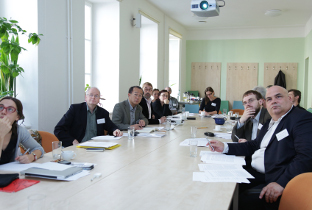
Photo Author: Stanislava Kyselová
The Friday session started off with a presentation by Iordan Avramov (Bulgaria), who showed how Henry Oldenburg, as secretary of the Royal Society, enlisted Central Europeans visiting England or the western parts of the Continent, and English travellers in Central Europe to provide information and source new contacts. Oldenburg acted in a systematic way by sending his contacts the names of people to be approached, and used ‘queries for natural history’ to gather information about the region. Philip Beeley (Oxford) explored why the city of Breslau became the centre of activity of the Academia Naturae Curiosorum and the contribution of Breslau curiosi to the growth of new knowledge. Important factors in explaining its significance were the intermediate position of Silesia between Germany, Bohemia and Poland, and the academy’s publication of the Miscellanea curiosa medico-physica, one of the earliest scientific journals. Iva Lelková (Prague) discussed Athanasius Kircher’s correspondence about natural philosophy with Jesuit mathematicians and their students at the University of Prague. These letters shed light on the development of science in Bohemia, which profited from the influx of Catholic scholars after the expulsion of the Czech Protestants. The last paper, presented by Maciej Jasiński (Warsaw), dealt with the amateur astronomer Stanisław Lubieniecki as an intelligencer. Lubieniecki integrated his correspondence with Johannes Hevelius about the appearance of two comets in 1644 and 1665 in his Theatrum Cometicum, while Hevelius used Lubieniecki’s help to disseminate his works and observations.
Hotson concluded the workshop by identifying some unifying themes. Recurrent topics were the loss of papers in and around the war and the strange absence of correspondence between individuals, communication strategies in building a correspondence network, the blurred boundary between ‘private’ and ‘institutional’ correspondence, and the tendency of correspondence to shade off into other genres of documentation, such as questionnaires, and to be integrated into publications.
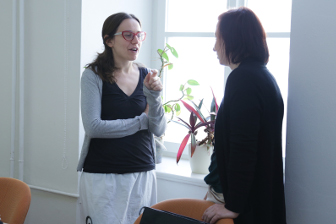
Photo Author: Stanislava Kyselová
Important factors in structuring the scholarly networks discussed are the continuity and discontinuity in the people and places central to intellectual exchange before, during and after the war, as well as the geographical, confessional and political maps of early modern Europe. Hotson also stressed the need to supplement correspondence with other genres of documentation of intellectual exchange, such as travel diaries, autobiographies and matriculation registers, and to bring these data together with technology in order to make the underlying patterns intelligible and perceptible through visualizations.
The small scale of the workshop provided an environment for personal interaction and I am confident that all participants look back on a successful and enjoyable conference. A volume of the revised papers will be published in the course of 2015.

